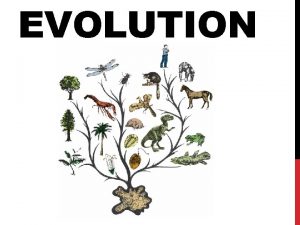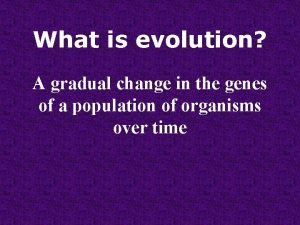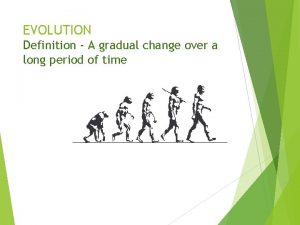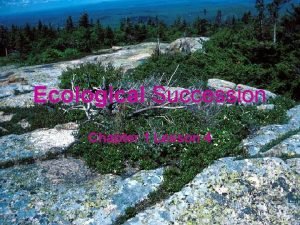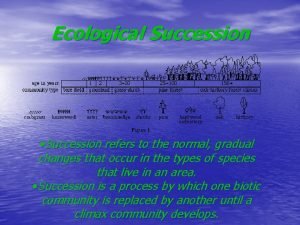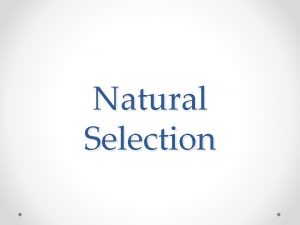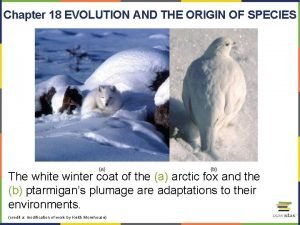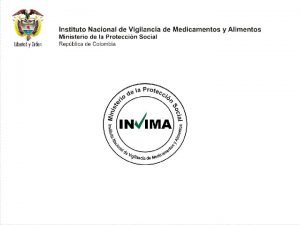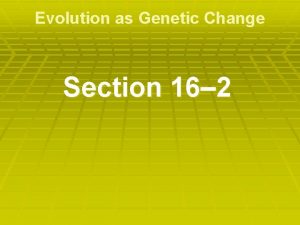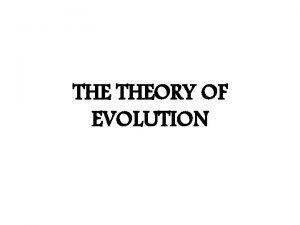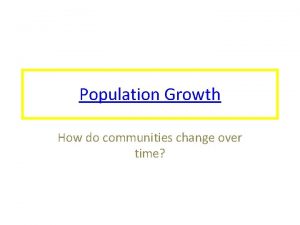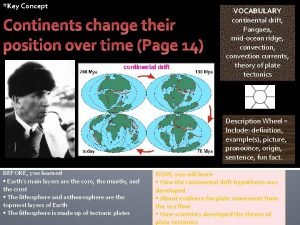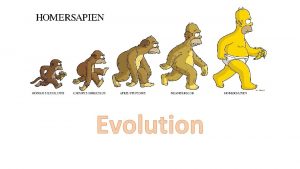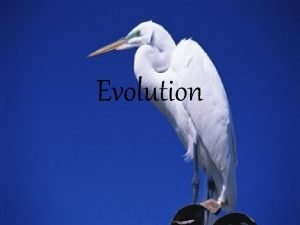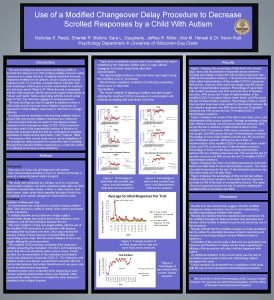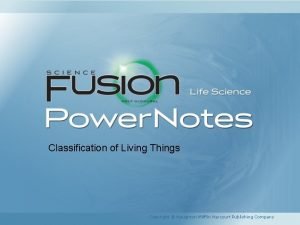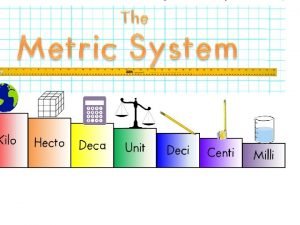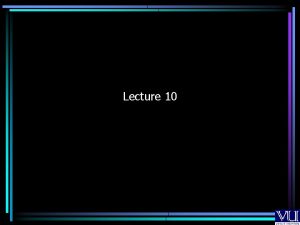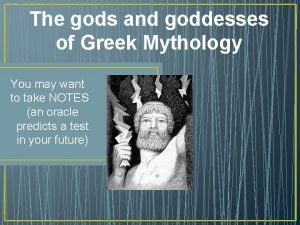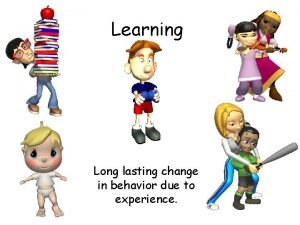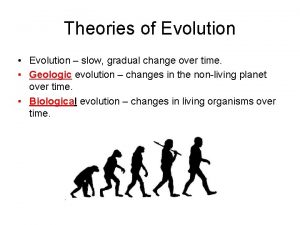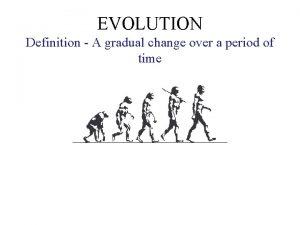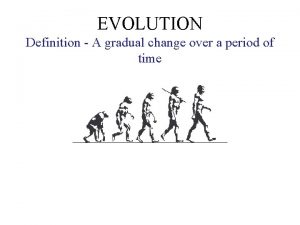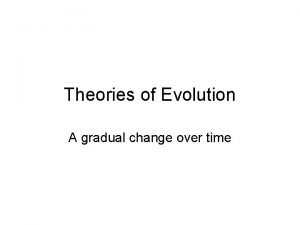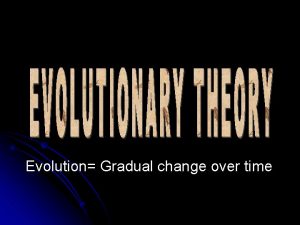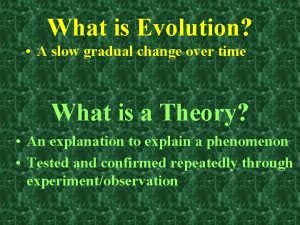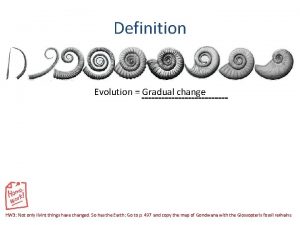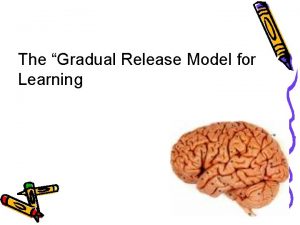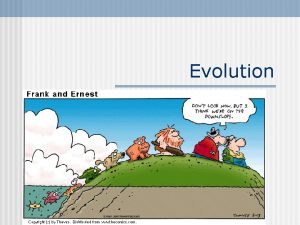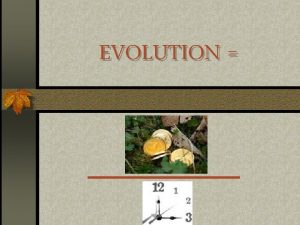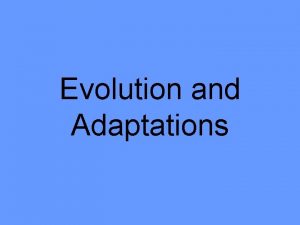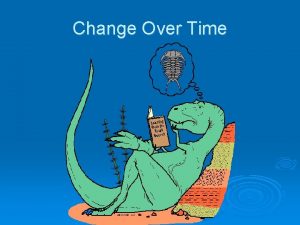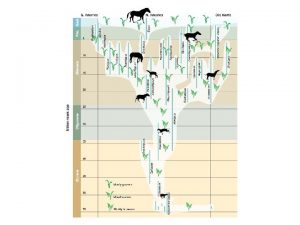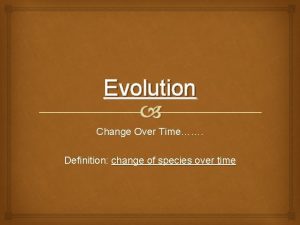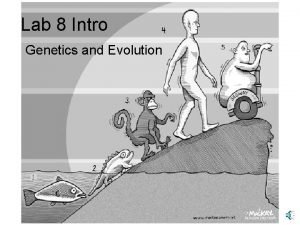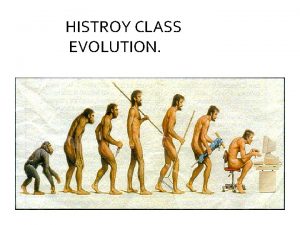EVOLUTION Definition A gradual change over a long




























































- Slides: 60

EVOLUTION Definition - A gradual change over a long period of time

What is a theory? Theories are statements or models that have been tested and confirmed many times They explain a wide variety of data and observations They can be used to make predictions

What is a theory? They are not absolute, they serve as a model of understanding for the world and can be changed as the world view changes The term "Theory" does not express doubt.


Charles Darwin Naturalist that observed many species Made many trips to the Galapagos Islands Observed finches, mockingbirds, tortoises Wrote the Origin of Species Purposed theory of Evolution through Natural Selection




Theory of Evolution by Natural Selection 1. Variation exists among individuals in a species



Theory of Evolution by Natural Selection 2. Individuals of species will compete for resources (food and space) called Struggle for Existence (Competition)

Theory of Evolution by Natural Selection 3. Some competition would lead to the death of some individuals, while others would survive. This is called Survival of the Fittest

Survival of the fittest through Adaptations – Decent with Modifications a) Adaptations are variations that help a species survive and reproduce. b) At first, adaptations are rare. As more of the species survive and reproduce, the number of individuals with the adaptation will increase. c) Other adaptations are inherited behaviors that help an organism find food, protect itself, or reproduce.

Theory of Evolution by Natural Selection 4. Individuals that had advantageous variations are more likely to survive and reproduce. Those variations come from mutations and sex reproduction. 5. This process he describes came to be known as Natural Selection.

What happens to species as the environment changes? • All organisms have traits that allow them to survive in specific environments. • If the environment changes, a species is more likely to survive if it has genetic variation, which results in a variation of traits. • If no individuals have traits that help them to survive and reproduce in the changed environment, a species will become extinct.

What happens to species as the environment changes? • Extinction occurs when all members of a species have died. • Greater competition, new predators, and the loss of habitat are examples of environmental changes that can lead to extinction. • Because a natural disaster can destroy resources quickly, organisms may die no matter what adaptations they have. • The fossil record shows that many species have become extinct in the history of life on Earth.

ADAPTIVE RADIATION


Summary of Darwin’s Theory of Natural Selection Organisms differ; variation is inherited Organisms produce more offspring than survive Organisms compete for resources Organisms with advantages survive to pass those advantages to their children (adaptations) Species alive today are descended with modifications from common ancestors (Adaptive Radiation)

Evidence Supporting Natural Selection 1. Fossil Evidence 2. Comparative Anatomy (Structural) 3. Embryonic Development 4. Geographic Distribution 5. Biochemistry

Evidence of Evolution Fossil Evidence Fossils are remains of once living organisms Fossils at bottom are older than fossils at top


Evidence of Evolution Comparative Anatomy Homologous Structures structures that are embryological similar, but have different functions, the wing of a bird and the forearm of a human (adaptations for environment)

Evidence of Evolution Vestigial Structures – structure that lost most or all of function do to lack of use Examples- Wisdom Teeth and Appendix


Evidence of Evolution Embryonic Development Early Embryonic Development is similar which implies they are related, having a common ancestor

Geographical Distribution Evidence Geographic Distribution Similar organisms from different locations were products of different lines of evolutionary descent


Evidence of Evolution Biochemical Biochemistry and DNA – by comparing DNA sequences of organisms shows common ancestry


Genetic Variation There are two primary sources of genetic variation: Mutations are changes in the DNA. A single mutation can have a large effect, but in many cases, evolutionary change is based on the accumulation of many mutations. Sex Reproduction can introduce new gene combinations into a population. This genetic shuffling is another important source of genetic variation

Genetic Variation Genetic variation and the Environment influence Natural Selection The environment determines which traits are favorable for survival

GENETIC RESISTANCE

Natural Selection is responsible for Antibiotic Resistance Bacteria and Pesticide Resistance Antibiotic resistance is the ability of bacteria or other microbes to resist the effects of an antibiotic


10 most dangerous antibiotic-resistant bacteria

MRSA Methicillin-Resistant Staphylococcus aureus


Pesticide Resistance defined as an inheritable genetic change in the sensitivity of a pest population that is reflected in the repeated failure of a product to achieve the expected level of control


Classification of Life on Earth constantly changes. This process led to Biodiversity is the variety of living organisms in a given area. Biologists have identified and catalogued 1. 5 million species so far. 2 to 100 million additional species yet to be discovered.

Why Classify? To study the great diversity of organism, biologists must give each organism a name. Taxonomy classifies organisms and assigns each organism a name. Latin and Greek are languages that would understood by all, so those are the languages that are used for scientific names.

Binomial Nomenclature Carolus Linnaeus, botanist developed two word naming system. Always in italics, First word, the genus, is capitalized, second word, the species, is lowercase. Examples are as follows:


Linnaeus’s system of classification

Example of classification


Traditional Classification vs. Modern Classification Linnaeus’ classified organisms according to their physical structures and anatomy. Modern classification classifies organisms according to their evolutionary descent, not just physical similarities. Let’s think about the dolphin? ?


Dichotomous Key A device used to easily and quickly identify an unknown organism. The user of the key is presented with a sequence of choices between two statements based on characteristics of the organism. By always making the correct choice, the name of the organism will be revealed.

Here is an example from your book

Phylogenetic Tree or Cladogram

Phylogenetic Tree Phylogeny is the evolutionary history of a kind of organism The tree is a branching diagram or tree showing the evolutionary relationships among various biological species based upon the physical and/or genetic characteristics



Answer is 4



 The gradual change in a species over time
The gradual change in a species over time A gradual change in a community over time.
A gradual change in a community over time. Gradual change
Gradual change Evolution is gradual
Evolution is gradual The gradual development of a community over time
The gradual development of a community over time What is a climax species
What is a climax species Natural selection
Natural selection Tall + short h
Tall + short h Once upon a time,there
Once upon a time,there Continuity and change thesis
Continuity and change thesis Orthogonal frequency division multiplexing
Orthogonal frequency division multiplexing Plan gradual de cumplimiento
Plan gradual de cumplimiento Gradual build up
Gradual build up Origin of species manga 18
Origin of species manga 18 Water hammer calculation
Water hammer calculation Gradual release of responsibility pedagogy
Gradual release of responsibility pedagogy Fluid mechanics
Fluid mechanics Opposition principle of design
Opposition principle of design Body effect coefficient
Body effect coefficient Afortunado adverb
Afortunado adverb Iv curve mosfet
Iv curve mosfet A substituição ordenada e gradual
A substituição ordenada e gradual Frost wedging drawing
Frost wedging drawing Plan gradual de cumplimiento
Plan gradual de cumplimiento Gradual dose reduction guidelines cms 2019
Gradual dose reduction guidelines cms 2019 Over the mountains over the plains
Over the mountains over the plains Siach reciting the word over and over
Siach reciting the word over and over Taking over navigational watch
Taking over navigational watch Section 16-2 evolution as genetic change
Section 16-2 evolution as genetic change Industry evolution and strategic change
Industry evolution and strategic change Slow evolution
Slow evolution Which blow over long distances?
Which blow over long distances? How do communities change over time
How do communities change over time A change of position over time
A change of position over time Direct changeover method
Direct changeover method Semantic shift words examples
Semantic shift words examples The change in the hereditary features over time
The change in the hereditary features over time Examples of natural selection
Examples of natural selection Change in hereditary features over time
Change in hereditary features over time Change over delay
Change over delay Why do classification systems change over time?
Why do classification systems change over time? Not so long ago, people
Not so long ago, people Once upon a time there lived a
Once upon a time there lived a What type of bird does the tinikling dance imitates?
What type of bird does the tinikling dance imitates? Once upon a time long ago and far away
Once upon a time long ago and far away Long long int c
Long long int c Greek
Greek để nguyên nước chấm cổ truyền
để nguyên nước chấm cổ truyền Once upon a long time ago
Once upon a long time ago Lông vằn lông vện mắt xanh
Lông vằn lông vện mắt xanh An event that leads to lasting change
An event that leads to lasting change Is mashing potatoes a chemical change
Is mashing potatoes a chemical change Physical change and chemical change
Physical change and chemical change Absolute change and relative change formula
Absolute change and relative change formula Definition of integer
Definition of integer Whats the difference between physical and chemical changes
Whats the difference between physical and chemical changes Difference between supply and quantity supplied
Difference between supply and quantity supplied Change in supply and change in quantity supplied
Change in supply and change in quantity supplied Change your water change your life
Change your water change your life Proactive and reactive change
Proactive and reactive change Physical change and chemical change
Physical change and chemical change
